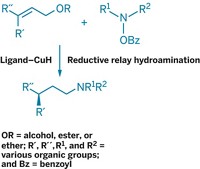Advertisement
Grab your lab coat. Let's get started
Welcome!
Welcome!
Create an account below to get 6 C&EN articles per month, receive newsletters and more - all free.
It seems this is your first time logging in online. Please enter the following information to continue.
As an ACS member you automatically get access to this site. All we need is few more details to create your reading experience.
Not you? Sign in with a different account.
Not you? Sign in with a different account.
ERROR 1
ERROR 1
ERROR 2
ERROR 2
ERROR 2
ERROR 2
ERROR 2
Password and Confirm password must match.
If you have an ACS member number, please enter it here so we can link this account to your membership. (optional)
ERROR 2
ACS values your privacy. By submitting your information, you are gaining access to C&EN and subscribing to our weekly newsletter. We use the information you provide to make your reading experience better, and we will never sell your data to third party members.
Synthesis
Chiral Tertiary Alcohols
Boron reagents direct which enantiomer a new route yields
by Sarah Everts
December 11, 2008
Making chiral tertiary alcohols has always been a tricky endeavor. Now, a research group led by Varinder Aggarwal, a chemist at the University of Bristol, in England, reports a new strategy using boron-based reagents to produce them (Nature 2008, 456, 778).
The work "is a superb piece of innovative reaction engineering," comments David MacMillan, who works on chiral synthesis at Princeton University.
Karl Hansen, the scientific director of chemical process R&D for Amgen, calls the strategy "striking" in an associated commentary. "Because a compound's enantiomers often have different biological activities, this could be particularly useful for drug discovery and development," Hansen notes.
Aggarwal's team starts with relatively easy-to-make enantioenriched secondary alcohols and converts the hydroxyl group into a carbamate group. Next, a base nips a hydrogen atom from the carbamate to form an intermediate anion. Then, a boron-based reagent reacts with the anion to provide the alkyl groups. The carbamate group is expelled, and hydrogen peroxide added to the pot reintroduces the alcohol functionality.
The step involving the boron reagent comes with "completely unexpected results," Aggarwal says. As it turns out, the nature of the reagent—that is, whether it is a boronate ester or a borane—dictates which enantiomer is produced, with striking selectivity. "The first time we did the reaction, it was completely investigative, and we did not expect such enantiomeric purity," Aggarwal says. His team reports making some two dozen tertiary alcohols this way, each with more than 90% enantiomeric selectivity.
"The capacity to build either enantiomer of the product from the same starting material simply by changing the nature of the boronate species is unique and important," MacMillan says. "This chemistry and the underlying concepts will be heavily utilized by the chemistry community."
Boron reagents "can act as sources of different alkyl groups," Hansen notes. "This means that a diverse set of products can be made conveniently from a common starting material."
Patrick J. Walsh of the University of Pennsylvania calls the work "very clever and interesting." But, he says, "Aggarwal's three-step method would really need to be highly efficient to compete" with his and other groups' strategies of single-step asymmetric additions to ketones using organozinc reagents and chiral titanium-based catalysts. These methods, he explains, "have been performed with high levels of enantioselectivity, greater than 90%," for similar compounds.






Join the conversation
Contact the reporter
Submit a Letter to the Editor for publication
Engage with us on Twitter